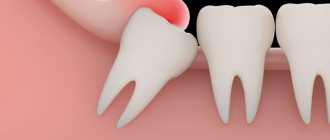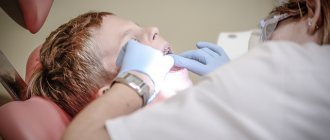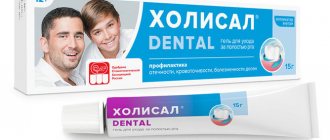Periocoronaritis is a dental disease characterized by inflammatory processes in the soft gum tissues that surround the erupting units (in the vast majority of cases, wisdom teeth). It manifests itself as intense pain, the inability to open the mouth normally, swelling of the gums, as well as an unpleasant odor from the oral cavity. Inflammation develops from the accumulation of plaque in the opening of the gum through which the unit erupts, or due to the difficulty of the process itself. The latter causes pressure on the adjacent unit along with damage to the bone and gum tissue.
The CELT Surgical Department of Dentistry invites you to undergo treatment for pericoronitis in Moscow. Our multidisciplinary clinic has been operating in the paid medical services market for more than two decades and enjoys a good reputation among patients. We have all the necessary certificates and licenses and provide treatment with the conclusion of an official contract and provision of a guarantee. You can find out the price of excision of the hood for periocoronitis or removal of a wisdom tooth by going to the “Services and Prices” section.
Consultation with a dentist-therapist - 1,000 rubles.
Treatment of pericoronitis with medication - 1,000 rubles.
Surgical treatment of pericoronitis (excision) - 2,500 rubles.
At CELT you can get advice from a dental specialist.
- The cost of a dental consultation is 1,000
Make an appointment
Etiology of pericoronitis
Most often (in more than 90% of cases), this disease is provoked by wisdom teeth, which begin to develop on the bulky area of the gums, which is located behind the third molars. The reasons for pericoronitis in this case lie in the fact that the width of the dental arch in modern humans has decreased by ten to twelve millimeters, but the teeth have retained their previous sizes. As a result, there is a lack of space for the eruption of units, which makes it difficult and manifests itself as inflammation.
Another reason lies in the too thick walls of the dental sac around the dental crown and gum mucosa, which also seriously complicate the teething of units. The reduction in growth-forming factors should not be discounted. During tooth growth, its position does not change, but part of its surface is hidden under the mucosa - and it is there that food fragments, pathogens and dental plaque begin to accumulate. Together, they create an ideal environment for the development of specific inflammatory processes, which are maintained due to regular trauma to other teeth during chewing. The result is scarring and an increase in the periodontal gap.
It is worth highlighting separately the factors that contribute to the development of dental periocoronaritis:
- early loss of primary teeth;
- malocclusion;
- abnormal increase in units – macrodentia;
- their complete or partial absence is adentia.
Treatment of pericoronitis
You need to understand that treatment of wisdom tooth pericoronitis with conservative methods is possible only in the early stages and in cases where there are good prospects for preserving the wisdom tooth. Conservative treatment involves the use of anti-inflammatory ointments and gels (Cholisal, Metrogyl Denta, etc.), as well as rinsing the mouth with antiseptic solutions (Chlorhexidine, Miramistin). However, in more than 90% of cases, exclusively surgical treatment methods are used - wisdom tooth removal.
How is pericoronitis treated?
- The gingival hood is dissected and the affected area is treated with antiseptic and antibacterial drugs.
- The gingival hood is removed. Excision of the hood for pericoronitis (removal of excess soft tissue) allows you to get rid of the source of infection and facilitate tooth eruption.
- Wisdom teeth are removed. The most common measure used for developmental disorders (retention, dystopia). Tooth extraction is also carried out in case of relapse of the disease and the appearance of a new hood.
Symptoms of periocoronaritis
The disease is characterized by intense pain symptoms localized in the area of the unit. Often it radiates to the temporal or ear region. The patient suffers from the inability to chew and swallow food normally, and even to open his mouth normally. As the inflammatory processes develop, they cover the surrounding tissues: pain is most often caused by the involvement of the gum hood, less often by the incorrect position of the growing units. If they are located at an angle, damage to the gum and bone tissue occurs, and there may also be pressure on the adjacent tooth, which often leads to its destruction.
Pericoronitis of the wisdom tooth also manifests itself:
- increased temperature in the affected area, sometimes in the whole body;
- enlargement of regional lymph nodes;
- the appearance of halitosis;
- unpleasant aftertaste when consuming food.
The lack of adequate treatment leads to the development of a purulent focus in the maxillofacial area of the face. The patient constantly secretes pus, the pain intensifies even at rest, and complications of pericoronitis develop, such as purulent melting of the subcutaneous tissue (phlegmon) or osteomyelitis.
Acute pericoronitis
As a rule, the disease begins with aching pain in the area of the erupting tooth, which becomes acute within 2-3 days. In this case, chewing on the affected side becomes difficult or impossible, and sometimes there is pain when opening the mouth and swallowing. The general condition is satisfactory, the submandibular lymph nodes are enlarged and painful (on the affected side. The causative tooth, as a rule, is half, and sometimes completely, covered with an inflamed, swollen “hood”, from under which pus with an unpleasant odor is released. Touching the “hood” causes severe pain, “shooting" in the ear, temple, upper jaw. Sometimes the temperature rises, up to 37-37.5, malaise and headache appear.
With poor quality treatment or self-medication, the process does not stop, but becomes chronic. The inflammation either subsides or worsens, while from under the “hood” a pyogenic liquid is constantly released, giving a foul odor from the mouth. The tooth gains some mobility due to the resorption of the bone around it.
The mucous membrane around the lower wisdom tooth is hyperemic and swollen. The process spreads to the mucous membrane covering the tooth or to the pterygomandibular fold, the mucous membrane of the palatoglossal arch, and cheeks.
The wisdom tooth is either completely covered with mucous membrane or the mucous membrane covers the far part of the crown. The crown of the wisdom tooth may shift to the buccal or lingual side, and the tooth may tilt forward. The tooth is located outside the dental arch.
Serous-purulent discharge is released from under the hood. Due to cicatricial changes in the edge of the mucous membrane above the tooth, outflow may be difficult. This often causes the infection to spread to adjacent tissues.
Acute pericoronitis can become chronic . In the chronic course of the process, inflammatory phenomena do not completely subside, and exacerbations often occur. During remission there are no complaints. An enlarged, slightly painful submandibular lymph node is detected. Opening the mouth is free and painless. The mucous membrane covering the wisdom tooth is hyperemic, painless or slightly painful on palpation. Sometimes a small amount of serous fluid is released from under the hood.
Complications of pericoronitis . The purulent process from the retromolar space along the adjacent tissue and layers of loose connective tissue can spread to adjacent tissue spaces. When penetrating outward, it reaches the lower fornix of the vestibule of the mouth, the buccal region; when spreading inward and posteriorly, it reaches the pterygomandibular, peripharyngeal and peritonsillar spaces; when spreading outward and posteriorly - into the parotid-masticatory area; when penetrating inside and anteriorly - into the sublingual and submandibular areas. As a result of the spread of infection in the cellular spaces, abscesses and phlegmons appear. Less commonly, bone tissue is involved in the purulent process. In these cases, osteomyelitis of the lower jaw develops.
Pericoronitis and retromolar periostitis can cause purulent lymphadenitis of the submandibular region, actinomycosis, and ulcerative stomatitis. Repeated exacerbation of the process during retromolar periostitis often leads to the death of the compact layer of the lower jaw branch and the development of secondary cortical osteomyelitis.
Difficult eruption of the lower wisdom tooth is complicated by the formation of a paradental cyst, caries, pulpitis and periodontitis of the wisdom tooth and second lower molar.
Classification of pericoronitis
Based on the shape of the flow, they are distinguished:
- Acute pericoronitis is typical for the primary manifestation of inflammation, and in the future, in the absence of treatment, for exacerbations of the chronic form;
- Chronic pericoronitis - characterized by repeated inflammatory changes in the mucosa around the erupting unit.
Depending on the clinical form of soft tissue inflammation, the following are distinguished:
- • Purulent pericoronitis in acute form – manifests itself with intense pain symptoms, deterioration of the general condition and an increase in temperature up to 30°C. Upon palpation, the doctor detects an increase in the submandibular lymph nodes. There is swelling of the mucous membrane in the area of the hood, cheeks and soft palate, pus flows from under the hood;
- Acute catarrhal pericoronitis - manifested by pain during chewing, body temperature remains within normal limits (as well as the tissues around the jaw do not swell), the patient can open his mouth normally. At the same time, the hood looks swollen, the entire crown of the tooth is under it, and exudate flows out from under it.
Symptoms of wisdom tooth pericoronitis
The clinical picture of emerging and developing pericoronaritis is pronounced:
- periodically occurring acute pain, which is characterized by “shooting” in the temporal zone and ear;
- problems with chewing food - pain and discomfort bothers you, because a person is not able to fully close his jaws;
- pronounced swelling of the soft tissues at the site of the problem tooth, the color of the gums changes to red and dark.
If at the stage of appearance of the listed symptoms there is no treatment, then the condition worsens, enlarged lymph nodes (cervical or submandibular), discharge of pus from the cavity (between the gum and tooth), and a slight increase in body temperature are added.
Most often, complicated pericoronitis with purulent inflammation occurs when the lower units erupt, which is associated with anatomical features. Sometimes this happens in children during the period of change from milk units to permanent ones.
Diagnosis of pericoronitis
The diagnosis is made by the dentist after an examination, taking into account the patient’s symptoms and complaints. In order to determine the direction of growth of the unit, an x-ray examination is often required. The main task of the doctor is to determine the form of the disease, its prevalence, nature and severity. In addition, he must identify contraindications to treatment:
- individual intolerance to medications or materials used in it;
- the presence of concomitant pathologies that will complicate treatment;
- inflammation of the tissues and organs of the oral cavity.
Pathogenesis of Pericoronitis
The pathogenesis of the inflammatory process in the oral cavity is associated with the formation and growth of an erupting tooth. Partial lifting of the gum forms a tissue formation - a periosteal flap, or, as it is also called, a “hood”, covering the part of the tooth that comes out of the gum. A pocket is formed under it, where plaque and food particles accumulate, as well as microorganisms that cause decomposition and decay processes, leading to a type of inflammation such as pericoronitis.
Any absorption of food by the patient is a supporting process of growth and development of pathogenic microflora in the patient’s oral cavity, during which the inflammatory process progresses. Mechanical damage to the gum mucosa also occurs here. The result is tissue changes that form scars on the body of the hood, as a result of which the periodontal gap quickly increases in size, bringing new suffering to the patient.
How to treat pericoronitis?
Treatment tactics for pericoronitis are selected by CELT dentists on an individual basis, depending on the diagnostic results and the patient’s indications. It is aimed at:
- pain relief;
- relief of inflammatory processes;
- restoration of the functionality of the dental system;
- excluding the development of complications.
Therapeutic manipulations are carried out on an outpatient basis, taking into account the severity of inflammatory processes, the local and general picture of the pathology and radiographic data. Treatment of the catarrhal form of acute periocoronaritis involves:
- antiseptic treatment of the area under the hood;
- application of antiseptic and anesthetic dressings;
- lifting the hood using a gauze strip soaked in iodine solution.
Treatment
You can't do it without the help of a doctor!
In the case of pronounced hyperemic edema and severe contraction of the jaws, the patient is prescribed a trigeminsympathetic blockade. If pericoronitis occurs without any particular complications, rinsing of the pocket under a tissue flap - a hood - is prescribed. This can be either a weak solution of potassium permanganate or a solution of furatsilin.
Local treatment is also prescribed, consisting of constant warm rinsing with a disinfectant solution and placing a tampon soaked in iodoform. Sulfonamide drugs and painkillers are prescribed for oral administration. Surgery may be performed if local therapy does not produce a positive result.
Curative surgery can act in 2 directions:
- Excision of the hood under local anesthesia to facilitate the eruption of a growing tooth and remove the infection that has accumulated under it.
- Extraction (removal) of a tooth in a position where tooth growth is impossible, or when it destroys another tooth nearby. As a rule, such manipulation is often performed with wisdom teeth, which have virtually no functional load in the oral cavity.
Pericoronitis, which causes relapses, can be cured only after removal of the corresponding tooth. Recently, laser therapy has become widely used to treat inflammatory processes associated with teething. Using a low-intensity infrared laser under local anesthesia, the resulting hood is excised, while simultaneously stimulating the flow of fresh blood to the surgical site.









